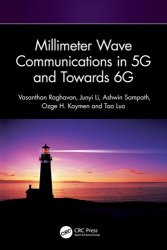Millimeter Wave Communications in 5G and Towards 6G
- Добавил: literator
- Дата: 22-09-2024, 14:41
- Комментариев: 0
 Название: Millimeter Wave Communications in 5G and Towards 6G
Название: Millimeter Wave Communications in 5G and Towards 6GАвтор: Vasanthan Raghavan, Junyi Li, Ashwin Sampath, Ozge H. Koymen, Tao Luo
Издательство: CRC Press
Год: 2025
Страниц: 298
Язык: английский
Формат: pdf (true), epub
Размер: 30.9 MB
This book explores different facets of millimeter wave systems, which form a central part of 5G systems. It explains how these systems serve as a foundational building block of 5G-Advanced/6G as these systems evolve.
Millimeter Wave Communications in 5G and Towards 6G focuses on millimeter wave channel modeling, radio frequency (RF) and antenna level constraints imposed on beamforming, beamforming design for link level incorporating the RF/antenna constraints and the channel structure, as well as system level deployment considerations. With significant academic and industrial experience, the authors are well-equipped in explaining how the millimeter wave research developed, the fundamental principles/math beneath the technology, and in explaining precisely the “Why?” behind the “What?” that make the 5G-NR specifications. The authors examine point-to-point systems at a single link level and show how the traditional sub-6 GHz-based beamforming procedures simplify to a simplistic signal processing approach of directional beam scanning. This book examines the foundational background that led to specific choices in the millimeter wave part of the 5G-NR spec as well as chart out the roadmap in terms of future research and development activities in this arena. The book ends by providing a scope of future research in this area.
5G stands for the Fifth Generation cellular mobile wireless technology. Before 5G, four generations of cellular technologies have been developed and widely adopted over the past 40 years across different geographies. The main goal of 5G is to be a unified platform or technology that can meet the vastly different requirements of eMBB, URLLC, and mMTC. To this end, 5G is characterized by a high level of design flexibility. For example, the subcarrier spacing (SCS) of OFDM transmissions can be 15⋅2i kHz in 5G, where i=0,…,6 with i=5 and 6 added in Rel. 17 of the standardization process. In contrast, it is always 15 kHz in LTE. The flexibility of the SCS leads to a variety of symbol and slot durations with which the network can optimally balance the tradeoff between overhead, latency and robustness to fading.
Another important reason for the design flexibility is that 5G utilizes a wide range of frequency bands. The previous generations of cellular mobile wireless technologies (1G–4G) use frequency bands under 7.125 GHz, somewhat informally called as “sub-7 GHz” frequencies or Frequency Range 1 (FR1) in 3GPP parlance. Millimeter wave (mmWave) bands are used in cellular wireless for the first time in 5G. The term loosely refers to bands above 24.25 GHz with the first release of 5G-NR specifying bands from 24.25 to 52.6 GHz, also known as Frequency Range 2 (FR2). MmWave bands exhibit very different wireless channel characteristics from sub-7 GHz bands. Moreover, the amount of channel bandwidths in these bands can be very different. RF circuitry and antenna design constraints in these bands are also more stringent than at sub-7 GHz. These differences impose quite distinct constraints and requirements on 5G design. As a result, careful attention in design needs to be paid to handle the diverse frequency bands and bandwidths supported by 5G.
This book is geared towards both introductory as well as advanced researchers in both industry and academia working in the areas of 5G, 5G-Advanced and 6G communications. It would also be useful for senior undergraduate and graduate students in universities focusing on wireless communications topics.
Contents:
Скачать Millimeter Wave Communications in 5G and Towards 6G
Внимание
Уважаемый посетитель, Вы зашли на сайт как незарегистрированный пользователь.
Мы рекомендуем Вам зарегистрироваться либо войти на сайт под своим именем.
Уважаемый посетитель, Вы зашли на сайт как незарегистрированный пользователь.
Мы рекомендуем Вам зарегистрироваться либо войти на сайт под своим именем.
Информация
Посетители, находящиеся в группе Гости, не могут оставлять комментарии к данной публикации.
Посетители, находящиеся в группе Гости, не могут оставлять комментарии к данной публикации.

